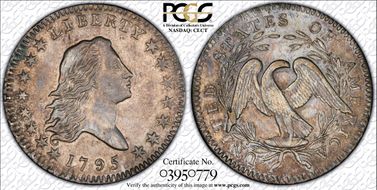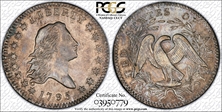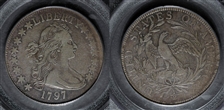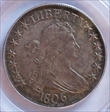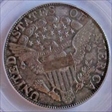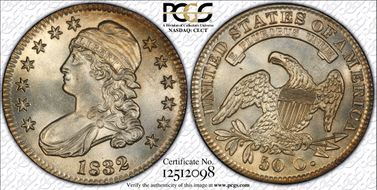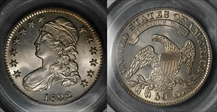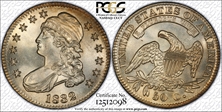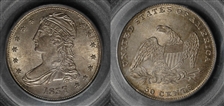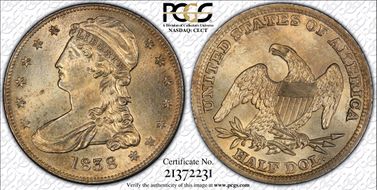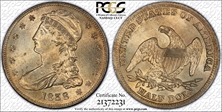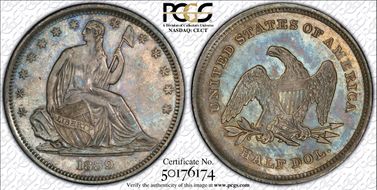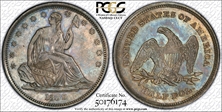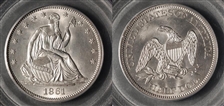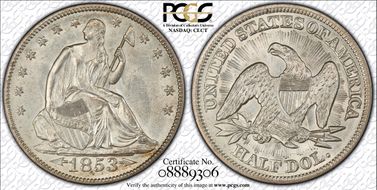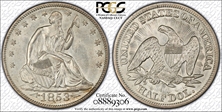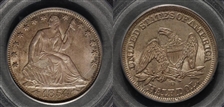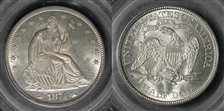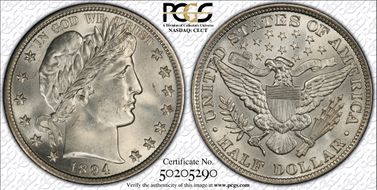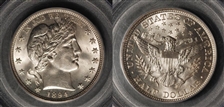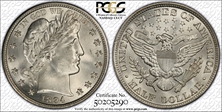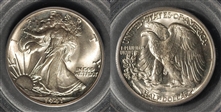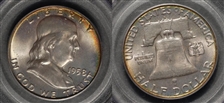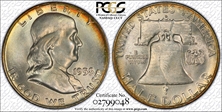Gobrecht's Raisinet Collection 的钱币相册
1795 50C 2 Leaves AU55. O-102, R.4. This piece is an intermediate die state, the obverse meeting Overton's requirements for O-102a and the reverse perfect as an O-102. It is also one of the finest known examples of the die marriage. In the fourth edition of Overton, Don Parsley recorded the Condition Census as 55, 45, 40, 30, 30. The finest examples to appear in recent auctions (and the only AU grade coins) are an AU55 ANACS piece that Heritage sold in November 2003 and an uncertified AU50 sold by Stack's in May 2001. Each side has a few minor scuffs and abrasions, but the overall eye appeal of this example is excellent. Satiny pale gray surfaces exhibit sharp design features with nearly full luster, accented by delightful gold and iridescent toning.
1795 50C 2 Leaves AU55. O-102, R.4. This piece is an intermediate die state, the obverse meeting Overton's requirements for O-102a and the reverse perfect as an O-102. It is also one of the finest known examples of the die marriage. In the fourth edition of Overton, Don Parsley recorded the Condition Census as 55, 45, 40, 30, 30. The finest examples to appear in recent auctions (and the only AU grade coins) are an AU55 ANACS piece that Heritage sold in November 2003 and an uncertified AU50 sold by Stack's in May 2001. Each side has a few minor scuffs and abrasions, but the overall eye appeal of this example is excellent. Satiny pale gray surfaces exhibit sharp design features with nearly full luster, accented by delightful gold and iridescent toning.
O-102 Low R.6. The rarest regular-issue US silver coinage design and solid for the grade. The Draped Bust, Small Eagle half dollar is one of the most difficult type coins to obtain, arguably the most difficult silver type coin, but not as rare as the 1796 No Stars quarter eagle or the 1808 quarter eagle. These half dollars, bearing the dates 1796 or 1797, come from a paltry mintage of 3,918 pieces, about 250 of which have survived the ravages of time. Half dollars of 1796-1797 are one of the rarest U.S. type coins and certainly one of the most expensive in virtually all levels of preservation. Even the most advanced collections often lack this rarity, and when present, it is usually in the low to middle grade levels, as here, and/or impaired, unlike this original, problem-free piece. There are four varieties of Draped Bust, Small Eagle half dollar. The first 1796 variety (Overton-101) displays 15 obverse stars, while the second has 16 stars (O-102). The two 1797-dated varieties (O-101 and O-102) share the same obverse but have different reverses, differentiated by the alignment of the peripheral lettering in relation to the central devices. The reverse of the 1797 Overton-101 variety was originally paired with the 1796 15 stars and 1796 16 stars obverses. During its use with the latter obverse, the reverse die developed a crack from the tip of the palm leaf below the base of the F in OF through the right side of O to the milling. This reverse developed even more cracks shortly after it was paired with the 1797 obverse die (O-101) and soon began to break up (O-101a). The breakup of the reverse die used in the 1797 Overton 101 and 101a varieties resulted in the employment of a new reverse die. The O-102 reverse differs from the old reverse in that the peripheral lettering is slightly offset in relation to the wreath.
1806 50C Pointed 6, Stem MS63. O-120a, R.4. A huge mintage of 839,576 Draped Bust half dollars was achieved in 1806, with 28 die varieties known for the date. A collection of 1806 die varieties and states would provide a monumental challenge. The O-120 reverse is one of those few numismatic situations where virtually every surviving coin could be considered a slightly different die state. This scarce variety is most easily identified by the die crack above the hair of Liberty on the obverse, and especially on the reverse by the broken patch on the shield, which gives the coin a special character not found on other varieties. Known as the Broken Shield variety, in its intermediate and late die states this variety is instantly recognized by (and popular for) the unusual, heavy die break, or "cud." A large piece broke out of the die right across the shield on the reverse, atop the fourth vertical stripe of the shield its earliest stages of progression. In later die states, this cud eventually extends across the shield until only the first vertical stripe is unaffected. This example is an intermediate state and is much earlier than that plated in the Parsley/Overton book. The shield die break encompasses all or part of three vertical stripes. The die break extends from pale 2 of gule 3 to a point midway between gules 5 and 6. Another break joins the left part of the first two horizontal shield stripes. Two die cracks join the border to the right ribbon end below M of AMERICA. These start at the same point on the border, with one crack following the right diagonal of the A, the other curving through M, with the area between these just beginning to sink into a retained cud. An additional crack extends through the tops of UNITE to the border over D. Many diagnostic die cracks are evident, including the crack across the tail feathers and the crack from the leaf to the base of RI. A couple light scratches in the right obverse fields serve to mark the pedigree of this piece, an intricately struck half dollar that lacks consequential abrasions. The actual design elements on each side of this lovely Draped Bust half dollar are boldly defined, within the context of the design type, with a well-centered impression and full obverse and reverse border details. The strike is crisp and full, with clear details even on the eagle's breast feathers, although a few of the upper hair details are weakly defined, as nearly always. The dusky grayish-silver colored obverse has considerable underlying mint luster, with iridescent tones of gold, pastel pink, sky blue and sea green circling the borders. The reverse has similar toning throughout and shimmering luster, swirling atop exceptional surfaces with none of the scratches mentioned for the obverse. This Select Mint State coin is a phenomenal example of this scarce variety, and one of the two or three finest known of the die state.
1806 50C Pointed 6, Stem MS63. O-120a, R.4. A huge mintage of 839,576 Draped Bust half dollars was achieved in 1806, with 28 die varieties known for the date. A collection of 1806 die varieties and states would provide a monumental challenge. The O-120 reverse is one of those few numismatic situations where virtually every surviving coin could be considered a slightly different die state. This scarce variety is most easily identified by the die crack above the hair of Liberty on the obverse, and especially on the reverse by the broken patch on the shield, which gives the coin a special character not found on other varieties. Known as the Broken Shield variety, in its intermediate and late die states this variety is instantly recognized by (and popular for) the unusual, heavy die break, or "cud." A large piece broke out of the die right across the shield on the reverse, atop the fourth vertical stripe of the shield its earliest stages of progression. In later die states, this cud eventually extends across the shield until only the first vertical stripe is unaffected. This example is an intermediate state and is much earlier than that plated in the Parsley/Overton book. The shield die break encompasses all or part of three vertical stripes. The die break extends from pale 2 of gule 3 to a point midway between gules 5 and 6. Another break joins the left part of the first two horizontal shield stripes. Two die cracks join the border to the right ribbon end below M of AMERICA. These start at the same point on the border, with one crack following the right diagonal of the A, the other curving through M, with the area between these just beginning to sink into a retained cud. An additional crack extends through the tops of UNITE to the border over D. Many diagnostic die cracks are evident, including the crack across the tail feathers and the crack from the leaf to the base of RI. A couple light scratches in the right obverse fields serve to mark the pedigree of this piece, an intricately struck half dollar that lacks consequential abrasions. The actual design elements on each side of this lovely Draped Bust half dollar are boldly defined, within the context of the design type, with a well-centered impression and full obverse and reverse border details. The strike is crisp and full, with clear details even on the eagle's breast feathers, although a few of the upper hair details are weakly defined, as nearly always. The dusky grayish-silver colored obverse has considerable underlying mint luster, with iridescent tones of gold, pastel pink, sky blue and sea green circling the borders. The reverse has similar toning throughout and shimmering luster, swirling atop exceptional surfaces with none of the scratches mentioned for the obverse. This Select Mint State coin is a phenomenal example of this scarce variety, and one of the two or three finest known of the die state.
1832 50C Small Letters MS64 PCGS. O-106, R.1. Mintage: 4,797,000. Star 1 is recut, instantly identifying this variety, and a tiny dotlike hole is seen at the lower shield vertex. The 5 in the denomination has a short, thick top. Line 1 of stripe 2 and line 2 of stripe 4 extend upward through two horizontal shield lines. The Draped Bust half dollar yielded to the perennially popular Capped Bust motif in 1807. In 1807 the Mint introduced a new half dollar design that collectors today have come to call the Turban Head or Capped Bust variety. This lovely near-Gem is highly lustrous with radiant silver-white surfaces and a bold strike. The coin is just a couple of trivial cheek abrasions away from full Gem status. Extremely high-end for the grade, and eye-appealing as well.
1832 50C Small Letters MS64 PCGS. O-106, R.1. Mintage: 4,797,000. Star 1 is recut, instantly identifying this variety, and a tiny dotlike hole is seen at the lower shield vertex. The 5 in the denomination has a short, thick top. Line 1 of stripe 2 and line 2 of stripe 4 extend upward through two horizontal shield lines. The Draped Bust half dollar yielded to the perennially popular Capped Bust motif in 1807. In 1807 the Mint introduced a new half dollar design that collectors today have come to call the Turban Head or Capped Bust variety. This lovely near-Gem is highly lustrous with radiant silver-white surfaces and a bold strike. The coin is just a couple of trivial cheek abrasions away from full Gem status. Extremely high-end for the grade, and eye-appealing as well.
1832 50C Small Letters MS64 PCGS. O-106, R.1. Mintage: 4,797,000. Star 1 is recut, instantly identifying this variety, and a tiny dotlike hole is seen at the lower shield vertex. The 5 in the denomination has a short, thick top. Line 1 of stripe 2 and line 2 of stripe 4 extend upward through two horizontal shield lines. The Draped Bust half dollar yielded to the perennially popular Capped Bust motif in 1807. In 1807 the Mint introduced a new half dollar design that collectors today have come to call the Turban Head or Capped Bust variety. This lovely near-Gem is highly lustrous with radiant silver-white surfaces and a bold strike. The coin is just a couple of trivial cheek abrasions away from full Gem status. Extremely high-end for the grade, and eye-appealing as well.
1837 50C MS64. The 1837 is one of only two issues of Christian Gobrecht's Reeded Edge, 50 CENTS Reverse Half Dollar. The Reeded Edge half dollars with "50 CENTS" on the reverse were the first U.S. regular-issue coin series struck on a steam press. The second and final year of the 50 CENTS reverse design, type collectors naturally gravitate to the 1837 since the 1836 is a famous, low mintage rarity, and technically a pattern issue. A paltry 1,200 pieces were struck the first year, and a more generous 3,629,820 coins in 1837, making this issue an important and desirable one for type collectors. The production of more than 3.6 million pieces appears generous, however, Uncirculated survivors are scarce, and only a slender portion of these pieces achieve status as a Gem. This near-Gem is a most impressive specimen, as its original surfaces give off glowing luster and medium intensity steel-gray toning. A few unobtrusive handling marks do not detract in the least. The design elements are evenly and fully struck in all areas, with 50 CENTS and all of stars fully impressed, enhancing the coin's outstanding eye appeal. A lack of consequential abrasions further contributes to the eye appeal.
A two-year type coin with the Capped Bust obverse, reeded edge, and HALF DOL. denomination, superseded in 1839 by the Seated Liberty half dollar. This piece shows generous luster over the silver-gold surfaces, with a sharp strike (save for star 12, often seen weak) and some striations near the obverse rim from 4 to 6 o'clock and correspondingly on the reverse, a phenomenon also frequently seen on this issue. Scattered traces of die rust appear, without in the least detracting from the premium appeal of this near-Gem half dollar.
A two-year type coin with the Capped Bust obverse, reeded edge, and HALF DOL. denomination, superseded in 1839 by the Seated Liberty half dollar. This piece shows generous luster over the silver-gold surfaces, with a sharp strike (save for star 12, often seen weak) and some striations near the obverse rim from 4 to 6 o'clock and correspondingly on the reverse, a phenomenon also frequently seen on this issue. Scattered traces of die rust appear, without in the least detracting from the premium appeal of this near-Gem half dollar.
1839 50C No Drapery MS62. This is a splendid Mint State example with deep steel and gray toning over satiny silver surfaces. The reverse has additional vibrant blue color. A sharply struck example with excellent eye appeal. This is a partial-year type coin, struck for a short time in 1839 and highly elusive in Mint State grades. Diagonal planchet striations are evident at the center of the reverse. Population: 4 in 62, 21 finer (8/06). From The Troy Wiseman Collection.
1839 50C No Drapery MS62. This is a splendid Mint State example with deep steel and gray toning over satiny silver surfaces. The reverse has additional vibrant blue color. A sharply struck example with excellent eye appeal. This is a partial-year type coin, struck for a short time in 1839 and highly elusive in Mint State grades. Diagonal planchet striations are evident at the center of the reverse. Population: 4 in 62, 21 finer (8/06). From The Troy Wiseman Collection.
PQ. A solidly struck and highly lustrous near-Gem from the Civil War years. Only a few stray marks appear on the cream-tinted surfaces. An uncommonly appealing No Motto piece.
1853 50C Arrows and Rays MS64 PCGS. Traces of golden-brown toning appear at 12 and 5 o'clock on the obverse. The satiny surfaces are otherwise pearl-gray. A sharply struck example of this scarce one-year design type with a few tiny marks on each side that keep the piece from Gem status.
1853 50C Arrows and Rays MS64 PCGS. Traces of golden-brown toning appear at 12 and 5 o'clock on the obverse. The satiny surfaces are otherwise pearl-gray. A sharply struck example of this scarce one-year design type with a few tiny marks on each side that keep the piece from Gem status.
1854-O 50C Arrows MS64. The antebellum O-mint production of this issue was a generous quantity in excess of 5.2 million coins, and with the Arrows feature to boot, the issue is frequently pursued for type coin purposes. According to Seated half expert Bill Bugert, there are 55 obverse dies and 33 reverse dies known for the issue, and some "interesting and rare" die marriages exist. An important branch mint example of this short-lived design type, the bulk of Half Dollar production during the years 1854 and 1855, the years in which the Arrows design was employed, went to the New Orleans Mint. Consequently, the majority of high grade survivors are O-mints. Sharply defined throughout, this near-Gem Choice example has good cartwheel luster. There are no significant abrasions, and willowy silver-gray patina blankets the well preserved, lustrous surfaces of this near-Gem, Choice Uncirculated example. The strike is among the strongest seen on an 1854-O Arrows Half. Every feature (the obverse star centrils and the eagle's right leg on the reverse included) is fully brought up, this despite a shattered obverse die as evidenced by numerous cracks. The dies for this coin attest to long use, as several small die cracks appear on each side. An interesting series of peripheral die cracks (as produced) is noted along the right (facing) obverse periphery, and along the lower reverse border (also as struck), pointing to a later die state, a testament to the compelling need for these new tenor pieces in circulation.
1884 50C Repunched Date, WB-102, MS66 PCGS. The motto IN GOD WE TRUST was added to the reverse of Seated Liberty coinage in 1866. Although the Civil War ended in 1865, the resumption of specie payments would have to wait for the passage of the Mint Act of February 12, 1873. As such, deliveries of half dollars from 1866-1873 remained low with the exception of a few S-mint issues. The first-year the Motto Half Dollar was produced was 1866, but only to the extent of only 745,625 pieces versus the 3.2 million pieces that were struck of the 1875-S. The P-mint Seated halves from 1879 to 1890 have tiny mintages, as series specialists can attest. This is due primarily to the millions of Morgan dollars that the Philadelphia Mint pumped out with annual celerity, mandated by the Bland-Allison Act. Mintages of Seated half dollars from 1879 to 1890 ranged from 4,400 to 12,001 business strikes per year. Of them all, the 1882 and 1884 mintages are tied for the smallest—4,400 pieces each year—as sufficient quantities of half dollars were in circulation. In effect, the paltry production makes every coin a first-strike representative, hence the larger proportion of markedly proof-like survivors. This popular issue has one of the smallest mintages in not only the Seated half dollar series, but all half dollar series from 1794 to present. Judging by the certified population data, collectors and/or the general public were certainly aware of the tiny mintages, as the numbers extant today are several times the typical surviving population. Of the 4,400 business-strike Seated Liberty half dollars struck in 1884, some of the rare high-grade examples, like the present coin, show deeply reflective proof-like fields. A spectacular gem example of this low mintage, late date Seated half, it is fully struck and the design elements are sharply detailed. The strike is razor-sharp throughout and tiny, well-concealed marks fail to distract. Originality is a hallmark of both sides. Rich toning in shades of cobalt-blue, violet, red, and golden-amber enhance the visual quality of this remarkable Premium Gem, forming a beautiful halo around untoned centers. The thickly frosted portraits of Liberty and the eagle generate significant, albeit undesignated proof-like contrast against the partly mirrored fields. The reverse fields are essentially fully proof-like. This toned, proof-like piece has high field-device contrast and only the most minor distractions. Highly reflective luster adds to the wonderful eye appeal of this superb coin, an exemplary 1884 half. Variety WB-102 with a Recut 4, struck from the business-strike die, the present coin shows minor recutting on the base of the 4. All circulation strikes show the 4 slightly recut north. A business strike-only die pairing, and one of only two, the other being the rare variant with the top of an errant 8 in the denticles beneath the 8 and 4. Provenance: Larry Whitlow
1874 50C Arrows MS63. Sharply struck and highly lustrous with frosty silver surfaces. Both sides are attractive with full brilliance and no trace of toning. Minor surface marks and abrasions keep this from the Choice category. An important type coin.
1894 50C MS65. For the connoisseur seeking a Gem quality example of this issue, consider this brilliant example. The surfaces of this Gem are nearly perfect, with soft, frosty silver luster. It is sharply struck with nearly full details on both sides. An extraordinary Gem.
1894 50C MS65. For the connoisseur seeking a Gem quality example of this issue, consider this brilliant example. The surfaces of this Gem are nearly perfect, with soft, frosty silver luster. It is sharply struck with nearly full details on both sides. An extraordinary Gem.
1894 50C MS65. For the connoisseur seeking a Gem quality example of this issue, consider this brilliant example. The surfaces of this Gem are nearly perfect, with soft, frosty silver luster. It is sharply struck with nearly full details on both sides. An extraordinary Gem.
1941 50C MS67. The entry issue into the widely collected 1941 to 1947 short set. The 1941 and 1943 are generally regarded as the best-produced coins in this short series for use as a type coin, even though the 1946-D is more available. This is an absolutely splendid example. A spectacular common date Walker, exhibiting dazzling, untoned surfaces that offer razor sharp detail and an almost total absence of noticeable blemishes. Even minuscule marks are hard to locate. While Mint State survivors of this high mintage wartime issue from the Philadelphia mint abound in today's market, few can compete with the technical merits of this Superb Gem. A simply lovely coin irrespective of date, the surfaces are fully lustrous with a bright, frosty sheen. Untoned and virtually blemish-free, both sides are fully brought up in all areas.
1958-D 50C MS66 Full Bell Lines. This was the final year that the Mint issued mint sets in cardboard holders with lots of sulphur to tone the coins. Tomaska noted: "Beautifully toned MS66 FBL and MS67 FBL 1958-D Franklins are usually among the most captivating coins in a top Franklin set. The colors are often dramatic - shimmering iridescent 'Peter Max' rainbows on the most spectacular pieces." A nearly perfect strike, practically flawless surface preservation, and attractive, slightly understated toning combine to make this Franklin half dollar an ideal type coin. One of the best preserved and prettiest mint set Franklins one of likely to set eyes on, this is a Premium Gem Franklin with likely mint set origins of this difficult late-series issue. This outstanding example is sharply detailed with a thin arc of colorful splashes of marvelous rose, orange, and lime-green iridescence captivating the viewer and enlivening both the obverse and the reverse rims. Vibrant, satiny, cartwheel mint luster illuminates the clean, colorful surfaces, and the strike is quite bold. Superbly defined, the excellent strike transcends the Full Bell Lines to include the lettering on the bell. Even among the normally well preserved mint set half dollars from this year, probably the source of this coin, only a small number of survivors could compete with the technical merits of this exceptional piece. The 1958-D Franklin Half dollar is the most available date of the series in Superb (MS67) Gem condition, because of its typically sharp strike. Still, Superb Gems with Full Bell Lines are quite rare. I'm happy with a well struck and magnificently preserved Premium (MS66) Gem that has spectacular eye appeal due to its vivid toning. A lovely specimen of this first year of the type issue.
1958-D 50C MS66 Full Bell Lines. This was the final year that the Mint issued mint sets in cardboard holders with lots of sulphur to tone the coins. Tomaska noted: "Beautifully toned MS66 FBL and MS67 FBL 1958-D Franklins are usually among the most captivating coins in a top Franklin set. The colors are often dramatic - shimmering iridescent 'Peter Max' rainbows on the most spectacular pieces." A nearly perfect strike, practically flawless surface preservation, and attractive, slightly understated toning combine to make this Franklin half dollar an ideal type coin. One of the best preserved and prettiest mint set Franklins one of likely to set eyes on, this is a Premium Gem Franklin with likely mint set origins of this difficult late-series issue. This outstanding example is sharply detailed with a thin arc of colorful splashes of marvelous rose, orange, and lime-green iridescence captivating the viewer and enlivening both the obverse and the reverse rims. Vibrant, satiny, cartwheel mint luster illuminates the clean, colorful surfaces, and the strike is quite bold. Superbly defined, the excellent strike transcends the Full Bell Lines to include the lettering on the bell. Even among the normally well preserved mint set half dollars from this year, probably the source of this coin, only a small number of survivors could compete with the technical merits of this exceptional piece. The 1958-D Franklin Half dollar is the most available date of the series in Superb (MS67) Gem condition, because of its typically sharp strike. Still, Superb Gems with Full Bell Lines are quite rare. I'm happy with a well struck and magnificently preserved Premium (MS66) Gem that has spectacular eye appeal due to its vivid toning. A lovely specimen of this first year of the type issue.
1958-D 50C MS66 Full Bell Lines. This was the final year that the Mint issued mint sets in cardboard holders with lots of sulphur to tone the coins. Tomaska noted: "Beautifully toned MS66 FBL and MS67 FBL 1958-D Franklins are usually among the most captivating coins in a top Franklin set. The colors are often dramatic - shimmering iridescent 'Peter Max' rainbows on the most spectacular pieces." A nearly perfect strike, practically flawless surface preservation, and attractive, slightly understated toning combine to make this Franklin half dollar an ideal type coin. One of the best preserved and prettiest mint set Franklins one of likely to set eyes on, this is a Premium Gem Franklin with likely mint set origins of this difficult late-series issue. This outstanding example is sharply detailed with a thin arc of colorful splashes of marvelous rose, orange, and lime-green iridescence captivating the viewer and enlivening both the obverse and the reverse rims. Vibrant, satiny, cartwheel mint luster illuminates the clean, colorful surfaces, and the strike is quite bold. Superbly defined, the excellent strike transcends the Full Bell Lines to include the lettering on the bell. Even among the normally well preserved mint set half dollars from this year, probably the source of this coin, only a small number of survivors could compete with the technical merits of this exceptional piece. The 1958-D Franklin Half dollar is the most available date of the series in Superb (MS67) Gem condition, because of its typically sharp strike. Still, Superb Gems with Full Bell Lines are quite rare. I'm happy with a well struck and magnificently preserved Premium (MS66) Gem that has spectacular eye appeal due to its vivid toning. A lovely specimen of this first year of the type issue.




















